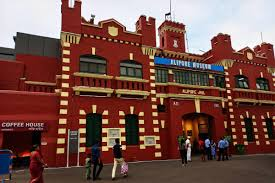
Introduction
Prison museums, often described as centers for ‘dark tourism,’ attract visitors seeking to explore the more somber aspects of history. This type of tourism, focused on locations associated with suffering, punishment, and death, presents complex ethical and emotional considerations. Exploring prison museums involves grappling with the legacy of incarceration, punishment, and justice. Reactions to these sites can be varied, reflecting the broader debate surrounding dark tourism and its implications.
Table of Contents
Understanding Dark Tourism
Defining Dark Tourism
Dark tourism, sometimes referred to as thanatourism, involves visiting locations associated with death, suffering, or the macabre. This includes prisons, battlefields, disaster sites, and locations infamous for their historical tragedies. The aim for many visitors is to gain insight into human suffering, historical events, or the conditions of past lives. Prison museums, with their focus on the history and conditions of incarceration, fit neatly into this category.
The Appeal of Prison Museums
Prison museums attract visitors for several reasons. For some, these sites offer a tangible connection to history, allowing them to witness firsthand the conditions that shaped past societies. Others are drawn by curiosity about the criminal justice system or the experiences of those imprisoned. The fascination with these sites also reflects a broader human interest in the darker aspects of history and justice.
Ethical Considerations
Respect for Suffering
One major concern with dark tourism, including visits to prison museums, is the potential exploitation of human suffering. Critics argue that such tourism can trivialize or commodify the experiences of those who suffered. For example, turning a former prison into a tourist attraction may risk reducing the profound suffering endured by prisoners to mere spectacle or entertainment.
Preservation vs. Exploitation
There is a delicate balance between preserving historical sites for educational purposes and exploiting them for profit. Prison museums often aim to educate the public about historical practices and human rights issues, promoting awareness and discussion. However, the line between respectful commemoration and commercial exploitation can be thin. The manner in which these sites are presented—whether through sensationalized exhibits or thoughtful, educational displays—can significantly impact public perception and the ethical standing of the museum.
Emotional and Psychological Impact
Visitor Reactions
Visitors to prison museums often experience a range of emotions, from shock and sadness to introspection. The raw depiction of harsh prison conditions and the stories of inmates can provoke a deep emotional response. Some visitors may leave feeling a greater sense of empathy or a more nuanced understanding of justice and incarceration. Others might find the experience unsettling or distressing, particularly if the exhibits are perceived as overly graphic or sensational.
Impact on Local Communities
The impact of prison museums extends beyond visitors to the local communities surrounding these sites. For some, these museums can serve as a means of economic development, attracting tourism and providing jobs. However, local communities may also experience discomfort or distress from having a site associated with suffering and punishment in their midst. The way in which a museum engages with and supports the local community can affect the overall reception of the site.
Educational Value
Promoting Awareness and Reflection
One of the primary goals of prison museums is to educate the public about historical and contemporary issues related to incarceration. By showcasing the conditions and experiences of past prisoners, these museums aim to foster a deeper understanding of justice, punishment, and human rights. Educational programs, guided tours, and informational displays can help visitors reflect on the broader implications of incarceration and the evolution of criminal justice systems.
Challenges in Education
Despite their educational potential, prison museums face challenges in effectively conveying their messages. Museums must balance the need to present accurate historical information with the risk of sensationalizing or distorting the past. Crafting exhibits that are both informative and respectful requires careful curation and thoughtful presentation. Additionally, visitors must approach these sites with an open mind and a willingness to engage with the complex issues presented.
The Role of Personal Reflection
Encouraging Critical Thinking
Prison museums offer opportunities for personal reflection and critical thinking. Visitors are encouraged to confront uncomfortable truths about history, society, and human nature. Engaging with the stories of individuals who experienced incarceration can provoke deeper questions about justice, rehabilitation, and societal values. This personal engagement is a key aspect of the dark tourism experience, prompting visitors to consider their own views on these issues.
The Influence of Context
The context in which a prison museum is visited can greatly influence a visitor’s reaction. Factors such as the visitor’s background, personal beliefs, and prior knowledge of the subject matter can shape their experience. For example, someone with a strong interest in criminal justice might find the museum particularly enlightening, while someone unprepared for the intensity of the exhibits might find it overwhelming.

Balancing the Experience
Best Practices for Prison Museums
To navigate the ethical and emotional complexities of dark tourism, prison museums can adopt best practices that emphasize respect, education, and sensitivity. This includes ensuring that exhibits are curated with care, avoiding sensationalism, and providing educational materials that foster understanding. Engaging with former prisoners, historians, and human rights experts can help create a more balanced and respectful portrayal of incarceration.
Visitor Responsibility
Visitors also play a crucial role in how prison museums are perceived. Approaching these sites with respect, empathy, and an openness to learning can enhance the educational value of the experience. Visitors should be prepared for the emotional impact of the exhibits and be willing to engage thoughtfully with the content presented.
Conclusion
Prison museums, as part of the broader phenomenon of dark tourism, provoke a spectrum of reactions and considerations. They offer a window into the harsh realities of incarceration and serve as tools for education and reflection. However, they also raise ethical questions about the commodification of suffering and the balance between preservation and exploitation.







